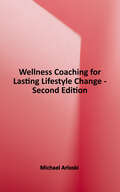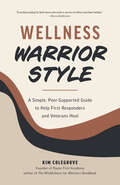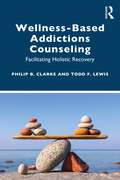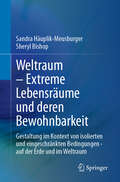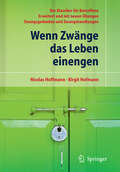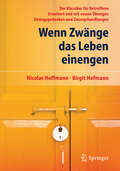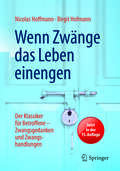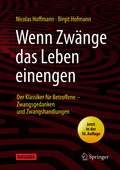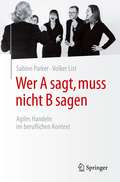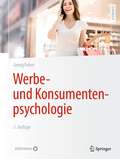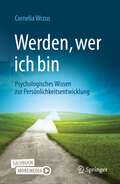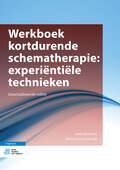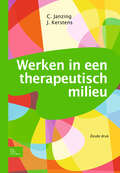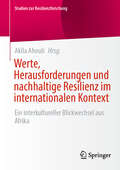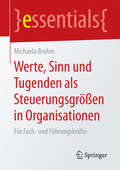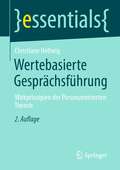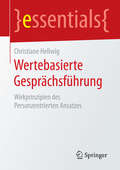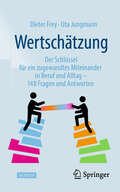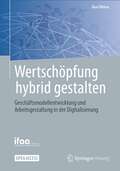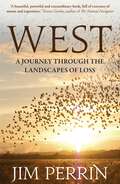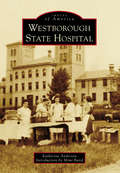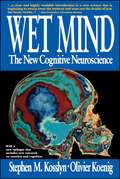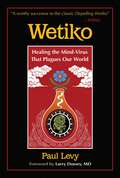- Table View
- List View
Wellness Coaching for Lasting Lifestyle Change
by Michael ArloskiGuided by his long experience as a wellness coach, Dr. Arloski blends the wisdom of the wellness field and the proven processes of the coaching profession to bring us an easy-to-use training tool, perfect for wellness professionals, life coaches, disease management professionals, wellness coach training, EAP professionals and therapists.
Wellness Warrior Style: A Simple, Peer-Supported Guide to Help First Responders and Veterans Heal
by Kim ColegroveA Warrior’s Roadmap to Healing Trauma “A book that will save lives and a book about those who save lives.”—Belles and RebellesWork stress relief—even after retirement—for first responders, veterans, service members, or others. Hear from warriors who credit author Kim Colegrove’s first book for saving their lives, and discover proven techniques and peer support to conquer long term effects of stress and restore your well-being as a resilient warrior.Reclaim your resilience and restore well-being. Wellness Warrior Style focuses on the unique challenges faced by those on the frontlines and offers support for all of society’s warriors, protectors, guardians, and healers. Understand the long term effects of stress, PTS (Post-Traumatic Stress), and find work stress relief tailored for first responders.Healing trauma for first responders. Whether you're a police officer, firefighter, emergency medical responder, mental health crisis worker, service member, warfighter supporter, veteran, or anyone else in public safety and service, take off your armor and set aside your shield. Let’s tackle these issues together.Inside, find:Personal stories from your peers, offering a sense of camaraderiePeer-supported resources, including culturally-relevant curriculum created by fellow warriors on Kim’s online platform, Pause First AcademyStrategies to help you navigate chronic stress with resilience and strengthHow to ask for help—and the importance of doing soIf you have read Walk the Blue Line, The Myth of Normal, or Nothing's Wrong, you’ll love Wellness Warrior Style.
Wellness-Based Addictions Counseling: Facilitating Holistic Recovery
by Todd F. Lewis Philip B. ClarkeThis book presents a culture change in addictions treatment that places wellness at the forefront of relapse, addiction, and recovery. The authors introduce a wellness-based conceptualization of addiction and recovery including the wellness model that grounds Wellness-Based Addictions Counseling (WBAC) and the techniques of this approach. Wellness-Based Addictions Counseling advocates for wellness as the primary variable in addiction and recovery outcomes, presents a wellness-based model of addiction and recovery, and highlights techniques for unlocking the motivational and strength-based aspects of this approach. Specifically, the authors provide wellness questions and screening tools to incorporate into the clinical evaluation and structure for creating a wellness plan and family wellness plan for the client’s loved ones. Readers will learn numerous wellness-based techniques related to the mind, body, spirit, emotions, and connection that can prevent relapse and facilitate well-being. All WBAC interventions are grounded in developmental, culturally responsive, and strength-based perspectives. Wellness-Based Addictions Counseling is essential reading for professionals who provide addictions treatment and counseling as well as scholars who conduct writing and research on addiction.
Weltraum – Extreme Lebensräume und deren Bewohnbarkeit: Gestaltung im Kontext von isolierten und eingeschränkten Bedingungen - auf der Erde und im Weltraum
by Sandra Häuplik-Meusburger Sheryl BishopDieses Buch erforscht kreative Lösungen für die einzigartigen Herausforderungen, die mit der Gestaltung bewohnbarer Räume in extra-terrestrischen Umgebungen verbunden sind. Ziel ist es, einen konstruktiven Dialog zwischen den Forschern und Planern zukünftiger (Weltraum-)Lebensräume zu fördern. Die Autoren untersuchen die verschiedenen Konzepte des Begriffs Habitability [auf Deutsch Bewohnbarkeit] aus der Perspektive der Bewohner sowie der Planer und Sozialwissenschaften. Das Buch gibt einen Überblick über die Entwicklung und die Fortschritte in der Gestaltung von Lebensräumen für bemannte Raumfahrzeuge und -habitate, und inkludiert auch analoge Forschungs- und Simulationseinrichtungen in extremen Umgebungen auf der Erde. Es zeigt auf, wie verschiedene Konzepte der Habitabilität gestalterisch umgesetzt wurden und welche noch fehlen. Der Schwerpunkt dieses Buches liegt auf der Identifizierung der wesentlichen Faktoren und kreativer Lösungen zur Schaffung von Lebensräumen, in denen sich Menschen wohlfühlen. Ausgewählte Aspekte werden vor einem sozial-räumlichen fachlichen Hintergrund diskutiert und mögliche Anwendungen aufgezeigt. Human Factors und Habitability Design sind wichtige Themen für jedwede Arbeits- und Lebensräume. Für die bemannte Erforschung des Weltraums sind sie von entscheidender Bedeutung. Zwar wurden menschliche Faktoren und bestimmte Aspekte der Bewohnbarkeit in den Entwurfsprozess von bemannten Raumfahrzeugen integriert, doch besteht die Dringlichkeit von der reinen funktionalen Überlebensfähigkeit, in ein den Menschen unterstützendes Design überzugehen. Seit einigen Jahren anerkennt die NASA das Risiko eines inkompatiblen Fahrzeug- oder Habitatdesigns als ein Hauptrisiko für die menschliche Gesundheit und Leistungsfähigkeit im Weltraum an. Die Bewohnbarkeit und die menschlichen Faktoren werden für die Gestaltung künftiger langfristiger und kommerzieller Weltraumeinrichtungen noch wichtiger werden, wenn größere und unterschiedlichere Gruppen Lebensräume außerhalb der Erde nutzen. Das Buch wird nicht nur Personen und Organisationen zugutekommen, die für bemannte Raumfahrtmissionen und Missionssimulatoren verantwortlich sind, sondern bietet auch relevante Informationen für Gestalter terrestrischer rauer Umgebungen (z. B. abgelegene Betriebs- und Forschungseinrichtungen, Krankenhäuser, Gefängnisse, Produktionsstätten). Darüber hinaus werden Erkenntnisse über die sozio-räumliche Beziehung vorgestellt, die für Sozialwissenschaftler, Ingenieure und Architekten im Allgemeinen von Interesse sind. Inhaltsverzeichnis Kurz : 1. Einleitung.- 2. Habitability / Bewohnbarkeit: Vom ORT zum (Lebens) RAUM.- 3. Bewohnbarkeit als (Lebens) RAUM.- 4. Rezension: Studien zur Bewohnbarkeit und Architektur von Mockups und simulierten Umgebungen.- 5. Rezension: Studien zur Bewohnbarkeit und Architektur in In-Situ-Umgebungen.- 6. Projektionen.- 7. Blick in die Zukunft: Wie man eine Blechbüchse in ein Zuhause verwandelt: Lösungen für ausgewählte Dimensionen der (sozialräumlichen) Bewohnbarkeit.
Wenn Zwänge das Leben einengen
by Nicolas Hoffmann Birgit HofmannWenn Zwänge das Leben einengen Zwangsgedanken und Zwangshandlungen können das Leben völlig lähmen oder ersticken. Von Angst- oder Ekelgefühlen getrieben, sieht sich der Betroffene gezwungen, die schrecklichsten Gedanken zu denken oder die unsinnigsten Handlungen auszuführen. So kommt es zu endlosen oder zeitraubenden Kontrollen, etwa ob die elektrischen Geräte ausgeschaltet sind. Oder der Betroffene verbringt sehr viel Zeit damit, seine Hände von vermeintlich gefährlichen Bakterien zu befreien. Ursachen, Behandlungsmethoden und Möglichkeiten der Selbsthilfe Die Autoren zeigen in ihrem Buch, wie Zwangserkrankungen entstehen welche Formen von Zwangserkrankungen es gibt welche Möglichkeiten die moderne Psychotherapie bietet, sich allein oder mit Unterstützung eines Therapeuten von diesen lästigen Ritualen zu befreien wie man als Angehöriger seinem Partner helfen kann. Geschrieben für Zwangskranke und ihre Angehörigen, für Therapeuten und Berater, die dieses Buch ihren Klienten empfehlen können, sowie für alle Interessierte. Der Klassiker für Betroffene - erweitert und mit neuen Übungen
Wenn Zwänge das Leben einengen
by Nicolas Hoffmann Birgit HofmannDer Klassiker für Betroffene - erweitert und mit neuen Übungen: Zwangsgedanken und Zwangshandlungen können das Leben völlig lähmen oder ersticken. Von Angst- oder Ekelgefühlen getrieben, sieht sich der Betroffene gezwungen, die schrecklichsten Gedanken zu denken oder die unsinnigsten Handlungen auszuführen. So kommt es zu endlosen oder zeitraubenden Kontrollen, etwa ob die elektrischen Geräte ausgeschaltet sind. Oder der Betroffene verbringt sehr viel Zeit damit, seine Hände von vermeintlich gefährlichen Bakterien zu befreien. Geschrieben für Zwangskranke und ihre Angehörigen, für Therapeuten und Berater, die dieses Buch ihren Klienten empfehlen können, sowie für alle Interessierte.
Wenn Zwänge das Leben einengen
by Nicolas Hoffmann Birgit HofmannDieser Selbsthilfe-Klassiker (bereits in der 15. Auflage) zeigt Betroffenen und ihrem Umfeld, wie Zwangserkrankungen entstehen, welche Formen von Zwangserkrankungen es gibt, welche Möglichkeiten die moderne Psychotherapie bietet, sich allein oder mit Unterstützung eines Therapeuten von diesen lästigen Ritualen zu befreien und wie man als Angehöriger seinem Partner helfen kann.Zwangsgedanken und Zwangshandlungen können das Leben völlig lähmen oder ersticken. Von Angst- oder Ekelgefühlen getrieben, sieht sich der Betroffene gezwungen, die schrecklichsten Gedanken zu denken oder die unsinnigsten Handlungen auszuführen. So kommt es zu endlosen oder zeitraubenden Kontrollen, etwa ob die elektrischen Geräte ausgeschaltet sind. Oder der Betroffene verbringt sehr viel Zeit damit, seine Hände von vermeintlich gefährlichen Bakterien zu befreien. In diesem Klassiker für Betroffene wird Hilfe greifbar.
Wenn Zwänge das Leben einengen: Der Klassiker für Betroffene - Zwangsgedanken und Zwangshandlungen
by Nicolas Hoffmann Birgit HofmannDieser Selbsthilfe-Klassiker (bereits in der 16. Auflage) zeigt Betroffenen und ihrem Umfeld, wie Zwangserkrankungen entstehen, welche Formen von Zwangserkrankungen es gibt, welche Möglichkeiten die moderne Psychotherapie bietet, sich allein oder mit Unterstützung eines Therapeuten von diesen lästigen Ritualen zu befreien, und wie man als Angehöriger seinem Partner helfen kann. Zwangsgedanken und Zwangshandlungen können das Leben völlig lähmen oder ersticken. Von Angst- oder Ekelgefühlen getrieben, sieht sich der Betroffene gezwungen, die schrecklichsten Gedanken zu denken oder die unsinnigsten Handlungen auszuführen. So kommt es zu endlosen oder zeitraubenden Kontrollen, etwa ob die elektrischen Geräte ausgeschaltet sind. Oder der Betroffene verbringt sehr viel Zeit damit, seine Hände von vermeintlich gefährlichen Substanzen zu befreien. In diesem Klassiker für Betroffene wird Hilfe greifbar. Geschrieben für ... Zwangskranke und ihre Angehörigen, für Therapeuten und Berater, die dieses Buch ihren Klienten empfehlen können, sowie für alle Interessierten. Die Autoren: Dr. phil. Nicolas Hoffmann ist einer der ersten deutschen Verhaltenstherapeuten und seit über 40 Jahren Dozent und Supervisor. Er ist Gründungsvorsitzender des Institutes für Verhaltenstherapie Berlin. Autor und Herausgeber zahlreicher Fachbücher. Dr. rer. nat. Birgit Hofmann ist Psychologische Psychotherapeutin (Verhaltenstherapie) in freier Praxis und Dozentin. Ehemalige Mitarbeiterin in Forschungsprojekten an der Universität Potsdam. Autorin mehrerer Fachbücher.
Wer A sagt, muss nicht B sagen: Agiles Handeln im beruflichen Kontext
by Volker List Sabine ParkerWer A sagt, muss nicht B sagen. Agiles Handeln im beruflichen KontextAgiles Handeln ist eine Lösungsoption, um unsichere und dynamische Zeiten erfolgreich zu meistern. In diesem Buch erfahren Sie Schritt für Schritt, wie Sie mit bestehenden Herausforderungen durch eine agile Haltung besser umgehen können. Doch wie wird man agil? Wie kann agiles Handeln gelernt werden? In diesem Buch finden Sie einen Weg, wie man Agilität erfahrungsorientiert entwickeln kann. Gewürzt mit einer kräftigen Prise Humor durch zahlreiche Karikaturen legt das Autorenteam Parker und List ein gut verständliches Trainingskonzept vor, das sich individuell in jedes Handlungsfeld übertragen lässt. Die gekonnte Vermittlung der Inhalte macht dieses Buch zu einem Lesegenuss und unterstützt Sie, agiles Handeln direkt umzusetzen und erfolgreich und zukunftsorientiert anzuwenden. Die ZielgruppenPersonal- und Organisationsentwickler, Berater, Führungskräfte, Trainer, Lehrkräfte, Theaterschaffende, Erwachsenenbildner und alle, die in ihrem beruflichen Kontext Menschen unterrichten, entwickeln und beraten. Die Autoren Sabine Parker M.A. (*1967) ist Personalentwicklerin, Kultur- und Theaterpädagogin, Gründerin und geschäftsführende Gesellschafterin der aisthetos akademie. Ihre Schwerpunkte sind die Personalentwicklung mit handlungsorientierten Methoden sowie die Ausbildung von Theaterpädagogen und Lehrkräften. Sie berät, trainiert und begleitet Menschen, Organisationen und Teams auf dem Weg zu mehr Kreativität und Agilität. Volker List (*1951) ist Doktor der Philosophie, Germanist, Politikwissenschaftler, Pädagoge, Business-Coach, Gründer der Forschungseinrichtung Angewandte Theaterforschung und Autor zahlreicher Publikationen. Seine Schwerpunkte sind die Gestaltung von Change-Prozessen mit kreativen Methoden, Rhetorik- und Präsentationstrainings sowie die Entwicklung innovativer Lernkonzepte.
Werbe- und Konsumentenpsychologie
by Georg FelserWie funktioniert Werbung? Wie werden Kaufentscheidungen beeinflusst? Wie manipulierbar sind wir als Konsumentinnen und Konsumenten? Welche Methoden im Marketing funktionieren und warum? Das Buch „Werbe- und Konsumentenpsychologie“ gibt Antworten auf diese Fragen. Mit der fünften Auflage des seit Jahren erfolgreichen und prüfungsrelevanten Lehrbuchklassikers halten Sie die psychologischen Grundlagen des Neuromarketings und der Verhaltensökonomie in Ihren Händen. Wussten Sie, dass ein nicht geringer Teil unseres Konsumverhaltens durch automatische, unbewusste und »implizite« Prozesse gesteuert wird? In diesem leicht verständlichen und gleichzeitig wissenschaftlich anspruchsvollen Buch erfahren Sie, welche Rolle diesen Prozessen tatsächlich zukommt. Diese Neuauflage wurde um eine Vielzahl aktueller Forschungsergebnisse sowie neuer Textabschnitte und Kapitel wie z.B. zum digitalen Marketing, Werbung über Influencer, die Bedeutung von Kundenrezensionen, die Folgen des E-Commerce, Online- und Versandhandel und „innovative“ Werbeformen wie z.B. Ambient Marketing oder Native Advertising erweitert.
Werden, wer ich bin: Psychologisches Wissen zur Persönlichkeitsentwicklung
by Cornelia WrzusStimmt es, dass Hans nicht mehr erlernt, was Hänschen nicht gelernt hat? Und wer formt unsere Persönlichkeit stärker – Eltern, Freunde, der Lebenspartner oder doch die Gene? Das Buch präsentiert den aktuellen Stand der internationalen psychologischen Forschung zum Thema Persönlichkeitsentwicklung. Es richtet sich an Menschen mit Interesse an fundiertem Wissen darüber, wie sich Persönlichkeitseigenschaften entwickeln, wobei kein Vorwissen in Psychologie erforderlich ist. Leserinnen und Leser erfahren, wie sich Eigenschaften von Menschen im Durchschnitt im Laufe ihres Lebens verändern, welchen Einfluss Gene und Umwelterfahrungen haben, welche Rolle Lebensereignisse spielen und inwieweit sich Eigenschaften durch Coaching, Therapie und ähnliche Anstrengungen beeinflussen lassen. Realistische und anschauliche Beispiele helfen, hilfreiche Aspekte in den eigenen Alltag zu transportieren. Unterhaltsame Grafiken sowie Podcasts vermitteln Fakten und Befunde in knapper, aufgelockerter Form (Edutainment). Geschrieben für … alle, die sich für Persönlichkeitsentwicklung interessieren – Führungskräfte, Psychotherapeuten, Coaches können mitlesen. Die Autorin: Cornelia Wrzus ist Professorin für Psychologische Alternsforschung an der Ruprecht-Karls-Universität Heidelberg. Sie interessiert sich für Persönlichkeitsentwicklung im Erwachsenenalter und Alter, Persönlichkeit und soziale Beziehungen im Lebensverlauf, Neurotizismus und Stressreaktionen in Alltagssituationen … und dafür, das verständlich zu vermitteln.
Werkboek kortdurende schematherapie: experiëntiële technieken
by Jenny Broersen Michiel van VreeswijkDit werkboek is onderdeel van de behandelmethode Kortdurende schematherapie. Schematherapie is een succesvolle en bewezen effectieve methode voor de behandeling van persoonlijkheidsproblematiek. Gebruikers van dit werkboek krijgen praktische handvatten aangereikt om in therapie bewust te worden van emotionele (problematische) gebeurtenissen in het hier-en-nu en vroeger. Zij leren deze gebeurtenissen te herkennen en ermee om te gaan. Er wordt gewerkt met historische rollenspelen, meerstoelentechniek, imaginatie-oefeningen en beeldende technieken. Iedereen heeft gevoelige snaren. Deze gevoelige snaren, zogeheten schema’s, bepalen hoe mensen in het dagelijks leven functioneren. Triggering van deze schema’s kan iemand in bepaalde gemoedstoestanden (modi) brengen. Sommige mensen ondervinden in hun dagelijks leven zo’n last van hun schema’s en modi dat er sprake is van een persoonlijkheidsstoornis. In deze geactualiseerde editie van dit werkboek ligt het accent op de (therapeutische) relatie en de experiëntiële technieken uit de schematherapie. Het is zowel te gebruiken voor individuele- als groepstherapie. Kortdurende schematherapie bestaat uit een handleiding voor de therapeut, een werkboek CGT-technieken en een werkboek experiëntiële technieken. De werkboeken kunnen los van elkaar worden gebruikt of achtereenvolgend. Beide werkboeken richten zich op het verminderen van de invloed van schema’s en modi op het dagelijks leven van cliënten.
Werken in een therapeutisch milieu: Naar samenhangend behandelen in de GGZ
by C. Janzing J. KerstensIn deze zesde druk van Werken in een therapeutisch milieu ligt het accent op het nastreven van samenhang in de hulpverlening. Het behandelprincipe is daarbij een sleutelbegrip. Dit boek bespreekt het therapeutisch milieu als opzet en organisatie van psychiatrische en psychotherapeutische behandeling. Het geeft aan hoe hulpverleners samenhang in hun bijdragen kunnen nastreven, door vast te houden aan een gekozen behandelprincipe. De eerste delen belichten het therapeutisch milieu en de plaats van de patiënt en de behandelgroep daarin. Vervolgdelen richten zich op de praktijk van groepen, milieutherapeutisch werken en management.Door de vele praktische voorbeelden en oefeningen is Werken in een therapeutisch milieu een toegankelijk leerboek en naslagwerk. Het boek is primair bestemd voor verpleegkundigen en sociaalpedagogisch hulpverleners. Daarnaast is het bruikbaar in diverse opleidingen en als handboek voor hulpverleners en leidinggevenden binnen de Geestelijke Gezondheidszorg in Nederland en Vlaanderen.
Werte der Hoffnung: Erkenntnisse aus dem Hoffnungsbarometer
by Andreas M. KrafftTäglich werden wir über die Medien mit negativen Nachrichten aus aller Welt konfrontiert. Kein Wunder, dass sich viele Menschen Sorgen machen, Ängste entwickeln und pessimistisch in die Zukunft schauen. Dieses Sachbuch berichtet in anschaulicher und überzeugender Weise über die Entstehung und Bedeutung von Weltanschauungen und universellen Werten als eine wichtige Quelle von Hoffnung. Seine Wirkungskraft gewinnt dieses Werk aus der Integration von Theorie und Praxis. Der Leser erfährt über die empirischen Ergebnisse aus dem Hoffnungsbarometer, einer jährlichen, wissenschaftlich breit angelegten Umfrage über die Hoffnungen der Menschen, die in einem philosophischen und psychologischen Gesamtzusammenhang prägnant dargestellt werden. Dadurch findet der Leser Antworten auf zentrale Fragen, die zu einer zukunftsorientierten und durch Zuversicht gekennzeichneten Lebensgestaltung verhelfen können: Welche Hoffnungen, Einstellungen und Werte sind für ein erfülltes und harmonisches Leben förderlich und welche halten den Menschen in einem selbst gebauten Gefängnis fest?Was kann der Einzelne tun, um in einer bedrohlich erscheinenden Welt zu einem Leuchtturm der Hoffnung für sich und andere zu werden? Wie kann die Menschheit aus der Sackgasse von Egoismus, Angst und Konfrontation herausfinden und auf einen Weg des gegenseitigen Verständnisses, der Zuversicht und des Friedens gelangen? Zielgruppen: Alle an Hoffnung interessierten Menschen und alle, die ermutigt in die Zukunft blicken möchten. Zum Autor: Dr. Andreas M. Krafft ist Associate Researcher am Institut für Systemisches Management und Public Governance an der Universität St. Gallen. Als Co-Präsident von swissfuture, der Schweizerischen Vereinigung für Zukunftsforschung, leitet er das internationale Netzwerk des Hoffnungsbarometers. Er ist Vorstandsmitglied des International Hope Institute in den USA.
Werte, Herausforderungen und nachhaltige Resilienz im internationalen Kontext: Ein interkultureller Blickwechsel aus Afrika (Studien zur Resilienzforschung)
by Akila AhouliAls Gegenbegriff zur Verletzbarkeit und Vulnerabilität profiliert sich das Resilienz-Ideal in der Forschung über und aus Afrika oft in Form der Problemlösefähigkeit und adaptiven Bewältigungskompetenz traditioneller Volkskulturen in Prozessen der Modernisierung, der Globalisierung und vor allem gegenüber den damit verbundenen sozio-ökonomischen Fehlentwicklungen, Konflikten und Krisen. Aus dem Blickwinkel der nunmehr über 50 Jahre bestehenden interkulturellen Germanistik in Afrika südlich der Sahara versuchen die im vorliegenden Band gesammelten Beiträge, sich von der im Krisen-Fetischismus quasi gefangen gehaltenen Forschungstradition zu entfernen, um sich mit Werten und Wertebildern auseinanderzusetzen, die Gesellschaften und Wissenschaften für ein positives Resilienzverständnis nachhaltig vorbereiten können. Dabei wird im Band folgenden zentralen Fragen nachgegangen: Welche positiven Werte können für vergangene, gegenwartsbezogene und zukünftige Krisensituationen fruchtbar gemacht werden? Nach welchen strategischen Mitteln werden diese Werte ausgearbeitet und übertragen? Welche Rolle spielt dabei eine afrikanische Germanistik, die sich als interkulturell versteht?
Werte, Sinn und Tugenden als Steuerungsgrößen in Organisationen: Für Fach- und Führungskräfte (essentials)
by Michaela BrohmMichaela Brohm stellt Konzepte und Strategien effektiver, wohlbefindlicher und lukrativer Organisationen vor. Sie erläutert, warum sich integre Führungskräfte mutig, gerecht und menschlich verhalten, und gibt Impulse für die werte- und sinnorientierte Individual- und Organisationsentwicklung. Wertvolle Anregungen, inspirierende Beispiele und ein umfassendes Inventar zu den Strategien werteorientierter Steuerung regen zum Transfer in die Praxis an.
Wertebasierte Gesprächsführung: Wirkprinzipien der Personzentrierten Theorie (essentials)
by Christiane HellwigPraxisnah erläutert die Autorin die grundlegenden Begriffe der Personzentrierten Theorie von Carl Rogers und ihre Bedeutung für eine wertebasierte Gesprächsführung. Auf dieser Basis wird die Relevanz der damit verbundenen humanistischen Haltung vermittelt und dargestellt, wie Menschen darin unterstützt werden können, ihrer Motivation auf die Spur zu kommen. Mit Beispielen aus dem Coaching und dem Führungsalltag wird eingängig beschrieben, wie die personzentrierten Wirkprinzipien dazu beitragen, im wörtlichen Sinn selbst-bewusster zu handeln; sie sind Erfolgsfaktoren und das Fundament wertschätzender Kommunikation. Und sie wirken kontextübergreifend: Sie sind Grundlage für Gespräche in psychosozialen genauso wie in wirtschaftlichen Arbeitsfeldern.
Wertebasierte Gesprächsführung: Wirkprinzipien des Personzentrierten Ansatzes (essentials)
by Christiane HellwigPraxisnah erläutert die Autorin die grundlegenden Begriffe des Personzentrierten Ansatzes und seine Bedeutung für eine wertebasierte Gesprächsführung. Mit der damit verbundenen Haltung werden Menschen darin unterstützt, ihrer Motivation auf die Spur zu kommen und im wörtlichen Sinn selbst-bewusst zu handeln. Die nach dem Personzentrierten Ansatz von Carl Rogers beschriebenen Wirkprinzipien tragen maßgeblich dazu bei und werden hier mit Beispielen aus dem Coaching und dem Führungsalltag eingängig dargestellt. Sie sind Erfolgsfaktoren und das Fundament wertschätzender Kommunikation. Und sie wirken kontextübergreifend: Sie sind Grundlage für Gespräche in psychosozialen genauso wie in wirtschaftlichen Arbeitsfeldern.
Wertorientierung und Sinnentfaltung im Coaching: Vorgehen und Praxisbeispiele nach dem St. Galler Coaching Modell® (essentials)
by Doris Ohnesorge Rudolf Engelbert FitzDoris Ohnesorge und Rudolf E. Fitz positionieren zunächst die These, dass Menschen sich Ziele nicht der Ziele wegen setzen, sondern weil sie Werte vermehren oder Wertverletzungen vermeiden wollen. Aufbauend darauf beschreiben die Autoren, warum und wie Werte im Zusammenhang mit Entwicklungsvorgängen der wesentliche Antrieb für Menschen sind. Diese Wirkung zeigt sich besonders im Kontext Führung, Beratung und Coaching. Werte beinhalten nämlich eine zentrale und starke Dynamik, den Sinn. Erst eine Sinnentfaltung lässt Menschen nicht nur zufrieden, sondern sinnerfüllt leben und arbeiten. Aus dieser Grundüberlegung heraus entstand das St. Galler Coaching Modell®, das auf Werteentwicklung ausgerichtet ist. Ziel der jahrelangen Evaluierung dieses Modells war es, alle entwicklungsrelevanten Elemente in Veränderungsvorgängen zu identifizieren und in ein systemisches und systematisches Modell zu übertragen.
Wertschätzung: Der Schlüssel für ein zugewandtes Miteinander in Beruf und Alltag – 148 Fragen und Antworten
by Dieter Frey Uta JungmannMit Wertschätzung handeln und behandelt werden – das wollen viele. Doch wie kann uns das in Zeiten von Krisen und Konflikten gelingen? Dieter Frey, anerkannter Sozial- und Organisationspsychologe, gibt darauf im Gespräch mit der Journalistin Uta Jungmann zahlreiche Antworten und macht deutlich: Gerade, wenn es schwierig wird, zeigt sich, wie wirkungsvoll Wertschätzung ist – als Kitt, der das Team im Unternehmen zusammenhält und stärkt. Als Bindeglied zwischen Menschen im Alltag, an der Universität, in der Schule oder der Familie. Für ein zugewandtes Miteinander am Arbeitsplatz und in einer von Spaltung bedrohten Gesellschaft. Anhand vieler Beispiele schildert der Psychologe, anschaulich und auf anregende Weise, wie sich mit Wertschätzung ganz konkret Brücken zu anderen Menschen bauen lassen, und mit ihr jeder einen Schlüssel für schwierige Situationen in der Hand hält. – Ein Buch für alle, die sich angesichts zunehmender Polarisierung tiefer mit Wertschätzung befassen möchten und überlegen, wie sie im Beruf gefördert werden kann – damit das Leben und Arbeiten in einer Welt des Umbruchs für alle entspannter wird.
Wertschöpfung hybrid gestalten: Geschäftsmodellentwicklung und Arbeitsgestaltung in der Digitalisierung (ifaa-Edition)
by ifaa – Institut für angewandte Arbeitswissenschaft e. V.In diesem Open-Access-Buch ist die Digitalisierung von Geschäftsmodellen anhand von Praxisbeispielen beschrieben. Dies umfasst einerseits die Entwicklung digitaler bzw. hybrider Geschäftsmodelle und andererseits die Gestaltung des Umsetzungsprozesses im Unternehmen. Dazu zählen Veränderungen an Strukturen der Aufbau- und Ablauforganisation ebenso wie an Zusammenarbeit, Führung und Kompetenzbedarf. Alle Vorgehensweisen und Lösungen sind anschaulich dargestellt. Damit verbundene Potenziale werden ebenso aufgezeigt wie kritische Erfolgsfaktoren.
West: A Journey Through the Landscapes of Loss
by Jim PerrinWest tells the story of Jim Perrin's life against the lives and deaths of his cherished wife and son, and the landscapes through which they traveled together. It is a complex and sensual love story, a celebration of the beauty and redemptive power of wild nature, and an extraordinary account of one man's journey towards the acceptance of devastating personal loss.
Westborough State Hospital (Images of America)
by Katherine AndersonOn the banks of Lake Chauncy sit the remains of the Westborough Insane Hospital, later known as Westborough State Hospital. Westborough is perhaps best known as the second homeopathic hospital for the insane in the United States and the first example of institutional reuse in the nation. The hospital's unique treatment methods put it squarely at the forefront of mental health treatment, and it was one of the last state hospitals in Massachusetts to close its doors. The pioneering African American pathologist Solomon Carter Fuller spent much of his career at Westborough studying the physical changes made to the brain by Alzheimer's. When it closed in 2010, it was the only state hospital in New England with a dedicated unit for deaf and hard of hearing patients. Though somewhat less infamous than some of its neighbors, Westborough holds a very distinctive place in the history of mental health treatment.
Wet Mind
by Stephen M. Kosslyn Olivier KoenigHow do our brains allow us to recognize objects and locate them accurately in space, use mental imagery to remember yesterday's breakfast, read, understand speech, learn to dance, and recall a new telephone number? Recent breakthroughs in brain scanning and computing techniques have allowed researchers to plumb the secrets of the healthy brain's operation; simultaneously, much new information has been learned about the nature and causes of neuropsychological deficits in animals and humans following various sorts of brain damage in different locations. In this first comprehensive, integrated, and accessible overview of recent insights into how the brain gives rise to mental activity, the authors explain the fundamental concepts behind and the key discoveries that draw on neural network computer models, brain scans, and behavioral studies. Drawing on this analysis, the authors also present an intriguing theory of consciousness. In addition, this paperback edition contains an epilogue in which the authors discuss the latest research on emotion and cognition and present new information on working memory.
Wetiko: Healing the Mind-Virus That Plagues Our World
by Paul Levy• Explores how wetiko covertly operates both out in the world and within our minds and how it underlies every form of self-destruction, both individual and collective • Reveals how wetiko&’s power lies in our blindness to it and examines how people across the ages have symbolized wetiko to help see it and heal it • Examines the concept of wetiko as it appears in the teachings of the Kabbalah, Hawaiian Kahuna shamanism, mystical Christianity, and the work of C. G. Jung In its Native American meaning, wetiko is an evil cannibalistic spirit that can take over people&’s minds, leading to selfishness, insatiable greed, and consumption as an end in itself, destructively turning our intrinsic creative genius against our own humanity. Revealing the presence of wetiko in our modern world behind every form of destruction our species is carrying out, both individual and collective, Paul Levy shows how this mind-virus is so embedded in our psyches that it is almost undetectable--and it is our blindness to it that gives wetiko its power. Yet, as Levy reveals in striking detail, by recognizing this highly contagious mind parasite, by seeing wetiko, we can break free from its hold and realize the vast creative powers of the human mind. Levy explores how artists, philosophers, and spiritual traditions across the ages have been creatively symbolizing this deadly pathogen of the psyche so as to help us see it and heal it. He examines the concept of wetiko as it appears in the teachings of the Kabbalah, Hawaiian Kahuna shamanism, Buddhism, and mystical Christianity and through esoteric concepts like egregores, demons, counterfeiting spirits, and psychic vampires. He reveals how visionary thinkers such as C. G. Jung, Sri Aurobindo, Philip K. Dick, Colin Wilson, Nicolas Berdyaev, and Rene Girard each point to wetiko in their own unique and creative way. He explores how the projection of the shadow self--scapegoating--is the underlying psychological mechanism fueling wetiko and examines wetiko in the context of the Covid-19 pandemic, showing that we can reframe the pandemic so as to receive the lessons and opportunities embedded in it. Revealing how the power of imagination can cure the wetiko mind-virus, Levy underscores how important it is for each of us to bring forth the creative spirit within us, which helps shed the light of consciousness on wetiko, taking away its power over us while simultaneously empowering ourselves.
